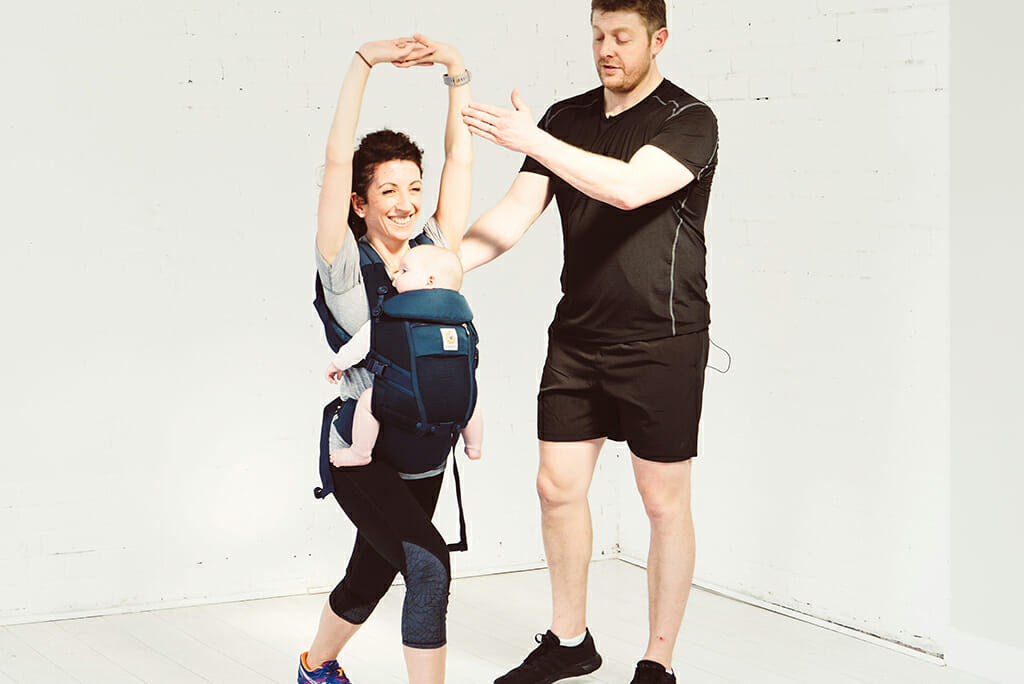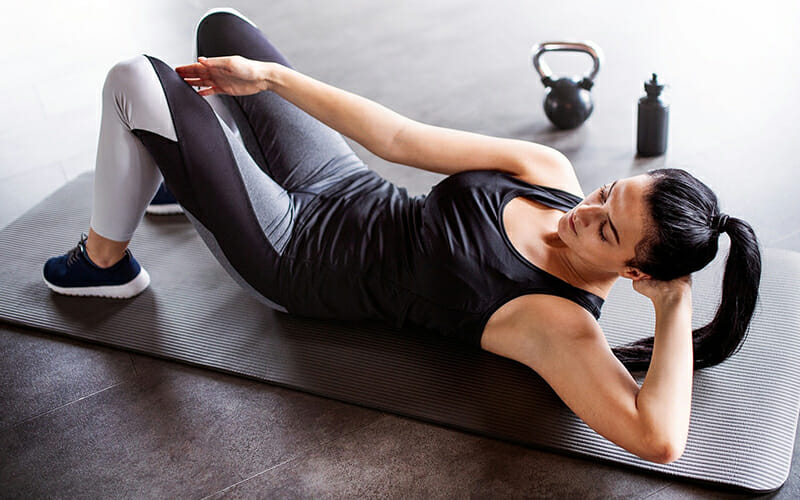
From our partners :
Delivery type, diastasis recti, pelvic floor. When you look to return to exercise after the arrival of your baby you are going to be bombarded with all sorts of information and some quite conflicting opinions. It was a desire to put all the info that new mums new from a range of cross medical and fitness experts that led us to create CARiFiT 4 ALL our free RCGP backed postnatal scheme.
For now let us take you through some simple and safe guidelines and things to consider and get you into the mindset that slow and steady wins the race when you’ve had a baby.
We’re stating the obvious here, but birthing and keeping alive a small human is an all-consuming task. With cluster feeds, nappy changes and sleepless nights on repeat, exercise slips way down (or falls right off) a new mum’s agenda. And that’s absolutely fine.
Slowly though, that newborn fog lifts (trust us), routines take shape and the thought of fitting in a workout doesn’t feel like climbing Everest. You want to get moving, but knowing where to start can be daunting. From diastasis recti to pelvic floor function, read on for everything you need to consider for a safe and successful return to exercise post-baby…
1. Type of Delivery
However your little one arrived into the world, it’s important to remember that your body has been through some serious trauma and performed an incredible task, so now is the time to respect that and let it recover.
If you had an uncomplicated vaginal birth, you can think about returning to exercise after 6-8 weeks, taking short walks and doing pelvic floor exercises before that. In fact, CARiFiT’s resident women’s health physiotherapist Lucy Allen advises that every woman should start pelvic floor exercises within 48 hours of delivery.
A C-section is more complicated, with a longer recovery period of at least 8-10 weeks. “Although at 6 weeks the superficial scar has healed, the abdominal muscles are significantly weakened with surgery,” says Lucy. “An episiotomy that has healed well with no complications doesn’t differ too much from a natural delivery, but with perineal tears, it depends on the grade of tear and healing. 3rd and 4th degree tears cause injury to the pelvic floor and anal sphincter complex that will take longer to regain strength and function. It’s a very individual thing, no matter the delivery the experience and recovery will be different so it’s a case of listening to your body. If you leak during exercise or feel vaginal pressure or back pain then you need to modify what you are doing.”
Ultimately, every birth and recovery is different, so it’s important to take an individualised approach and not run before you can walk – quite literally. The physio sessions in our CARiFiT 4 ALL scheme can help explain further as can this brilliant blog on recovery times.
2. Your Pre-Pregnancy Fitness Levels
With both types of delivery, recovery and return to exercise will depend on various factors, notably your fitness levels both pre and during pregnancy.
Forget the archaic notion of needing to ‘take it easy’ – the benefits of exercising throughout pregnancy are plentiful, from keeping your body strong and stable as your bump grows to building the stamina you’ll need during the birth. You’ll also be less susceptible to postural changes, joint pain, fatigue and pregnancy complications. Once baby arrives, the fitness levels you worked hard to maintain throughout your pregnancy will make the return to exercise quicker, easier and safer.

3. All. The. Hormones.
Lunges feeling a bit wobbly? That’ll be relaxin.
As the name implies, this hormone relaxes the ligaments and muscles and widens the cervix in preparation for birth, but it doesn’t just disappear once your baby is born. As well as balance issues, relaxin makes a new mum’s joints particularly fragile, so high-impact exercises are out and low-impact exercises are in. Emotionally, general postpartum mood swings can make exercise feel like the last thing you want to do, but working out can improve your mood and boost confidence. Hormones play such a huge role in your 1st year as a new mum and understanding the role they play can take huge pressure off you at this precious time, you can learn more in this blog post.
4. Pelvic Floor Function
It’s a common misconception that pelvic floor function is only an issue if you had a vaginal birth, but pregnancy itself puts considerable pressure on your pelvic floor, so it’s important to start pelvic floor exercises as soon as you feel ready post-birth.
But how do you know if your pelvic floor isn’t functioning as it should be? “Incontinence, vaginal heaviness, visible prolapse or palpable on wiping and pain are signs that something isn’t right,” says Lucy. “It’s recommended to see a physio as soon as possible if feasible, but especially if any of first three symptoms do not improve with modifying exercise and doing pelvic floor exercises 3 times a day for 12 weeks.”
5. Diastasis Recti aka. The Tummy Gap
Diastasis recti (DR) is the separation that occurs between the rectus abdominis (six pack muscles) as the line alba (connective tissue) expands to accommodate your growing baby.
DR is completely normal during pregnancy, and 99% of women will experience it. “A gap of more than 2 fingers needs rehab if you are wanting to return to high impact exercise, but the key thing is the tension along the linea alba,” says Lucy. “If, when contracting, you aren’t getting much and there’s doming then rehab is needed to prevent back pain or herniation.” Work on restoring your core with our free guide and practice good alignment and breathing to control intra-abdominal pressure.
6. Breastfeeding
Don’t panic: research has shown that light to moderate exercise does not affect your milk supply, composition or taste.
There are however, a few things to consider. Hydration is key; so drink water before, during and after your workout. Breastfeeding requires calories, so ensure you fuel yourself with nutritious, sustaining food, especially when exercising. Feed or express before you workout to avoid discomfort from full breasts and finally, invest in a supportive sports bra – because nothing helps with fitness motivation like a nice new piece of kit. A full article on breastfeeding and exercise is available here.

7. Mum Guilt
Research by This Girl Can revealed that 61% of mums feel guilty about taking time to workout.
We get it, but as the saying goes, “you can’t pour from an empty cup”. Taking time for yourself – both mentally and physically – is so important when you’ve had a baby. CARiFiT alleviates mum guilt by getting your little one involved. The benefits of babywearing are endless, from reducing crying to encouraging bonding. All you need is a carrier, baby and 30 minutes. If you’re lucky, you might even get a sleeping baby at the end of it. Mum guilt? What mum guilt?
8. Unrealistic Expectations
Your pre-baby fitness regime may have put an athlete to shame, but even the most well-intentioned new mums find that getting back into exercise doesn’t quite go to plan once baby is here.
It’s important to understand that it will take time to ease into a routine, both physically and mentally. Your body will feel and move differently, which is why the type of exercise you do is so important. Post-natal exercise may be low impact, but that doesn’t mean it’s low intensity – you’ll be surprised how quickly you heart rate goes up when you’re doing a squat and press while wearing your little one. Listen to your body, pace yourself and trust the process. Those pre-baby fitness levels aren’t lost forever, we promise. If you want to delve further into new mum motivation then this article by Dr Bernadette Dancy is a fantastic place to start.
9. Sleep Deprivation
You know exercise will make you feel good, but you’re too tired to do it – it’s the cruel catch 22 that comes with being a new mum.
Ultimately, exercise gives you energy, but it’s important to listen to your body. Take each day as it comes and try to fit in some movement, whether it’s a walk with baby or as many rounds of a CARiFiT session as you feel up to. Then, if baby nods off, put them down and sneak in a quick catnap yourself. Win win. Sleep, how to get some and how much your baby needs is a topic that is never far from any new parents mind and you can get some key stats and much needed sleep tips by taking a look at this sleep blog post.

10. Women’s Health Physio Appointment
While the six-week GP check is seen as a postnatal milestone, it can be a bit, well, perfunctory.
If budget allows, a women’s health physio appointment is a worthwhile investment. “The initial appointment for a new mum is a complete mental and physical check up,” says Lucy. “We take a full in-depth history of symptoms and delivery then offer assessment of the pelvic girdle/spine, abdominal and an internal vaginal examination (if consented) to fully assess pelvic floor strength, range of movement, co-ordination and check for any laxity or prolapse. At the end of a session you are given a rehab programme to be continued independently or progressed in future appointments.” If seeing a women’s health physio isn’t possible, in our CARiFiT 4 ALL section you will find pelvic health tutorials from Lucy along with insights from medical professionals and postnatal experts to get you moving safely again.




